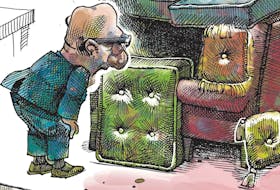The Ivany Report, on growing the economy of Nova Scotia, proposed an ambitious 10-year time frame to implement policies aimed at a provincial economic turnaround. While it sets a series of lofty goals, for the most part related to economic development and increased population, it supplies no direction on how to meet them.
It is one thing to call for a 50 per cent increase in business startups, an increase of annual exports by 50 per cent and doubling revenue from the tourism industry – it is quite another to meet those objectives. Realistically, only the most perennially optimistic among us would give even an outside chance of these goals being attained in a 10-year time frame.
In the area of population the report calls for a dramatic increase in immigration. The report dismissed the question of which has to come first, immigration or economic expansion, characterizing the relationship as a chicken/egg argument. If what comes first is not clear to the drafters of the Ivany report it is clear to Nova Scotian residents moving to Alberta to obtain one of the many jobs available there. The report recommended that we must be more open and welcoming to new immigrants. The fact that former Alberta premier Ralph Klein welcomed the first wave of Nova Scotians with the designation of "Eastern Canadian bums," with no noticeable effect on the exodus, further underlines the importance of what comes first. The reports framing of the issue shifts focus away from the primary population problem facing the entire western world and most of the developed world – precariously low birth rates.
The report also proposes globalization-inspired dynamic urban centres, to end the rural/urban divide. There are valid concerns about this approach given the singular ascendancy of Halifax to that status. The expectation that a strong Halifax economy will trickle down to the rest of the province has little basis in fact. The decentralizing of government departments has been a recognized economic tool in this country for decades. Halifax's maintenance of the lion’s share of the province’s civil service jobs factors into financial indicator reports placing Halifax in the enviable position of all green marks while Cape Breton labours under significant red marks. Given the recent economic hardships befalling Pictou County an argument can be made that the opposite of a trickle-down effect is occurring, a sort of black-hole effect, where everything gravitates towards the centre.
At first glance the proposal of a non-partisan approach to economic renewal by all the political parties is the most promising aspect of the report. Premier Stephen McNeil's formation of the OneNS Coalition naming himself chair with vice-chairs Jamie Baillie and Maureen MacDonald representing the other parties meets the report's recommendation of political co-operation. In some instances, that co-operation is advisable and potentially effective, in others it is questionable if it is in the best long-term interests of Nova Scotians.
While some have questioned the lack of urgency in the OneNS Coalition's end of 2015 timetable to create a plan, as opposed to the report’s sense of urgency, the lack of concrete steps in the report made that delay inevitable. Of more concern is the three parties agreeing on a common way forward on issues related to the province’s decline that are a result of previous and current government actions.
In a nod to one of these issues the report recommended the province lower its debt-to-GDP to 30 per cent or less. A section of the report is titled, The Government-Led Economy 1950-1995. In the 1980s a staggering 40 per cent of the province’s GDP, the highest percentage of any Canadian province, was created by the public sector. That sector is still the largest component of the provincial economy. The report outlines the political divide between those that believe there is too much government spending dragging down the economy and those that believe continued government growth is the way forward. In ducking the issue the report states, "an extended debate about government versus private sector economic leadership may distract attention away from the tough choices we now face in Nova Scotia."
McNeil's government, to this point, has made two significant moves on the financial front. First, a budget that failed miserably to tackle the deficit/debt problem. Second, the announcement of a new statutory holiday in February. Neither the work/school days typically lost to bad weather that time of year, nor the costs associated with the day, were enough to deter them. While business anticipates their costs at $130 million, which will be passed on to consumers, it appears McNeil's government did not stop to calculate the total government cost. A conservative estimate would be one of the two percentage points the Liberals failed to lower the GST by.
Al Muir is a local businessman and resident of Plymouth who keeps a close eye on the political front, both local and nationally. He can be reached at [email protected]








